![]()
In this paper we review the ancient writing systems used by people in Middle Africa, and the cognate writing systems they spread to Asia . Special emphasis will be on pottery writing, Egyptian writing, Libyco-Berber writing, and the writing systems of ancient Nubia.
![]()
By
Clyde Winters
ABSTRACT
In this paper we review the archaeological, historical and linguistic evidence that indicates that Africans have a long tradition of literacy from ancient to modern times using their own writing systems. Examples of the African inscriptions will be discussed, and their possible contemporary use by members of African secret societies will be explained.
Ancient Writing Systems
Since the rise of worldwide Western European supremacy it has been argued that Africans, due to a strong oral tradition, failed to invent writing. As a result, opposition to Afrocentrism has been the unfounded belief that only Egypt had writing in Africa (Appiah 1983).
Although it is alleged that Africans were always illiterate, archaeological, historical, and epigraphic evidence indicate that Africans invented many writing systems. And that these writing systems were used from ancient times all the way up to the present (Bekerie 1994).
We will show in this paper that archaeological evidence indicates that African literacy began in the Sahara over 5000 years ago (Winters 1971, 1981a,1983). This earliest form of writing was a syllabic system that included hundreds of phonetic signs, which over time was shorten to between 22 and 30 key signs, and used as an alphabet by the Egyptians, Meroites, Phonesians and Ethiopians.
The original inhabitants of the Sahara where the Egyptian or Kemitic civilization originated were not Berbers or Indo-Europeans (Winters 1985b). This was the ancient homeland of the Dravidians, Egyptians, Sumerians, Niger-Kordofanian-Mande and Elamite speakers is called the Fertile African Crescent (Anselin 1989, p.16, 1992; Winters 1981,1985b,1989, 1991,1994). The inhabitants of this area lived in the highland regions of the Fezzan in modern Libya and Hoggar until after 4000 B.C. We call these people the Proto-Saharans (Winters 1985b, 1991). The generic term for this group is Kushite.
The Proto-Saharans were called Ta-Seti and Tehunu by the Egyptians. In the archaeological literature they were called A-Group and C-Group respectively. Farid (1985, p.82) noted that:
We can notice that at the beginning of the neolithic stage in Egypt on the edge of the Western Desert corresponds with expansion of the Saharian Neolithic culture and the growth of its population .
The Fertile Saharan Crescent is an arc shaped series of highland regions in the Saharan zone of Africa. The Saharan zone is bounded on the north by the Atlas mountains, the Atlantic Ocean in the West, the tropical rain forest in the south and the Red Sea in the East. It was here that the ancestors of the founders of the river valley civilizations in Africa, the Middle East, China and Indus Valley developed their highly organized and technological societies (Winters 1983a, 1985b).
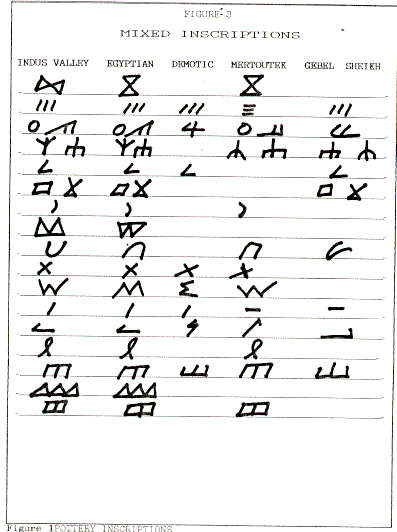
The discovery of Intercultural style vessels from Susa (in Iran),Sumerian, Egyptian and Indus Valley sites suggest a shared ideological identity among these people (Kohl 1978). In fact the appearance of shared iconographic symbols and beliefs within diverse areas suggest cultural and ethnic unity among the people practicing these cultures. The common naturalistic motifs shared by the major civilizations include, writing (symbols), combatant
snakes , the scorpion, bull and etc. This evidence of cultural unity is explained by the origin of these people in the Proto-Sahara (Winters 1985a, 1989).
The Proto-Saharans or Kushites used similar terms for writing. In general the term for writing was formed by the labial stops /p/ and /b/. For example:
|
Dravidian par 'write' |
|
Manding bo, bu 'make a stroke', sebe 'write' |
|
Elamite tipu 'to write' |
|
Galla tafa 'to write' |
There are also other corresponding terms for 'mark', or 'draw' that begin with velar stops:
|
Dravidian kiri, kuri 'write, draw, mark' |
|
Egyptian hti 'carve' |
|
Manding kiri, kiti 'mark' |
In Egyptian we have several terms for write 0 ss #, 0 zs # , and 0 ssw #. During the Old Kingdom writing was referred to as 0 iht # .
The Egyptian term for writing 0 ssw # is analogous to the Mande terms 0 sewe # or 0 sebe # 'writing, trace, design'. In Dravidian among other terms we have rasu 'write', and shu 'writing' in Sumerian. The Egyptian term 0 zs # is also closely related to Sumerian 0 shu #.
Writing systems among African people were mainly devised for two purposes. Firstly, to help merchants keep records on the business venture they made. Secondly, the Proto-Saharan script was also used to preserve religious doctrines or write obituaries.
The scarcity of documents, written for historical preservation among ancient African groups resulted from the fact that the keeping of history, was usually left in the hands of traditional (oral) historians. These historians memorized the histories of their nation and people for future recitation before members of their respective communities. This oral history was often accompanied by music or delivered in poetic verse and remains the premier source for the history of most African nations even today.

It is obvious that the first inscriptions were engraved in stone by the Proto-Saharans , or a stylus was used to engrave wet clay (Winters 1985b). The use of the stylus or stick to engrave clay is most evident in the pottery marks found on the pottery excavated at many ancient sites which possess similar symbols impressed on the pottery.
This view is supported by the fact that the term for writing in Dravidian and Egyptian include the consonants /l/, /r/ or /d/.
A "u", is usually attached to the initial consonants (Winters 1985b). For example:
|
Sumerian ru, shu |
|
Elamite talu |
|
Dravidian carru |
|
Egyptian drf |
These terms agree with the Manding terms for excavate or hollow out 0 du #, 0 do #, 0 kulu #, 0 tura #, etc. The Sumerian term for writing was 0 du #. This show that the Proto-Saharan term for writing denoted the creation of impressions on wet clay and hard rock.
The origin of writing among the Proto-Saharans as an activity involving the engraving of stone is most evident in the Egyptian language. This hypothesis is supported by the Egyptian words 0 m(w)dt #. The term 0 md t # means both '(sculptor's) chisel' and 'papyrus-roll, book'. The multiple meanings of 0 md t # makes it clear that the Egyptian, and probably other descendants of the Proto-Saharans saw a relationship between engraving stone and the creation of books.
Other Egyptian lexical items also support the important role Proto-Saharans saw in engraving rocks, and writing. In addition to md t we have, 0 hti # 'carve, sculpture' and 0 iht # 'writing'. The fact that iht is an Old Kingdom term for writing, almost identical to hti, is further evidence that writing involved the engraving of stone.
POTTERY INSCRIPTIONS
The Proto-Saharan writing was first used to write characters on pottery (Winters 1980), to give the ceramics a talismanic quality . Similar signs appear on Chinese, Harappan, South Indian Megalithic, Libyan and Cretan pottery (see figure 1). These signs were invented by the Proto-Saharans for purposes of communication. These pottery signs agree with the so-called linear Egyptian signs mentioned by Petrie (1921, p.83). They frequently appear on Egyptian pottery .
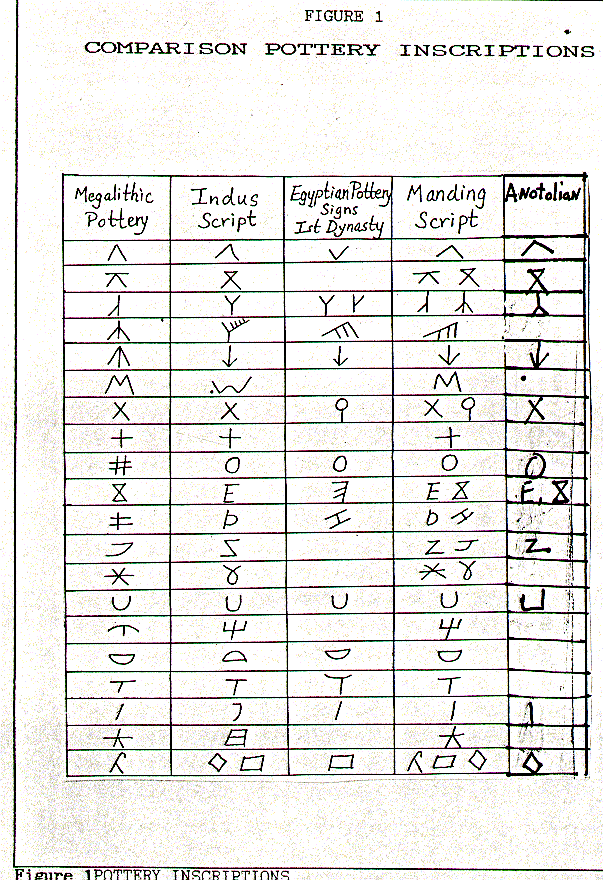
The Egyptian pot marks in Upper and Lower Egypt. Petrie (1900) was the first to record the Egyptian potmarks. These potmarks are found on pottery dated to Dynasties O to I (van den Brink 1992). These Thinite potmarks published by van den Brink (1992) agree almost totally with the Oued Mertoutek, Gebel Sheikh Suleiman, Harappan, Proto-Elamite and Proto-Sumerian (see figure 3).
SYLLABIC WRITING
It is clear that a common system of record keeping was used by people in the 4th and 3rd millennium B.C. from Saharan Africa, to Iran, China and the Indus Valley. Although the Elamites and Sumerians abandoned the Proto-Elamite writing and the Uruk script respectively, in favor f cuneiform writing, the Dravidians, Minoans (EteoCretans) and Manding continued to use the Proto-Saharan script (see figure 2) (Winters 1985c).
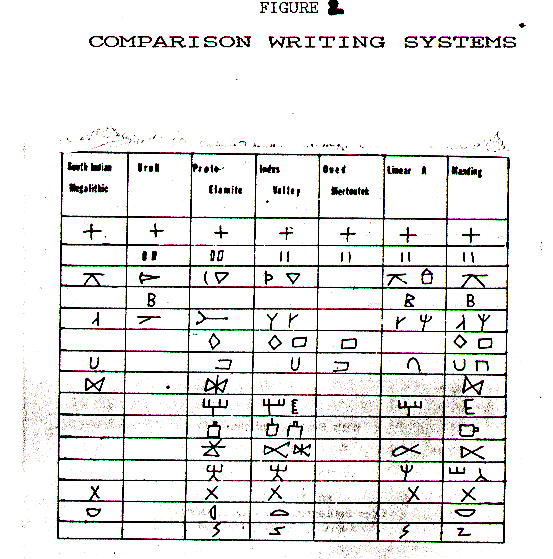
The pottery signs were symbols from the Proto-Saharan syllabic writing. David (1955) was sure that the Dravidian and Cretan writings were analogous to the Egyptian pottery script.
Moreover Dr. J.T. Cornelius (1956-57) used epigraphic evidence to show that the graffiti marks on the South Indian Megalithic pottery has affinity to other ancient scripts including the Libyan, Egyptian and Cretan signs.
The languages of the Dravidians, Elamites, Sumerians and Manding are genetically related (Winters 1985d, 1989b, 1994). N. Lahovary (1957) noted structural and grammatical analogies of Dravidian, Sumerian and Elamites. K.L. Muttarayan (1975) provides hundreds of lexical correspondences and other linguistic data supporting the family relationship between Sumerian and Dravidian. C. A. Winters (1980, 1985d, 1989b, 1994) and L. Homburger (1951) have provided evidence of a genetic relationship between the Dravidian languages and the Manding Superset of languages. Dr. Homburger has also proven that the Manding and Coptic languages are closely related.
The oldest Proto-Saharan inscriptions come from Oued Mertoutek and Gebel Sheikh Suleiman. These inscriptions are over 5000 years old (Wulsin 1941; Winters 1983a ).
The Oued Mertoutek inscription was found in the Western Sahara (see figure 4). This inscription was found on the lower level of Oued Mertoutek and dated to 3000 B.C. by Wulsin (1941). The Oued Mertoutek inscription like other Libyco-Berber writing is in the Manding (Malinke- Bambara) languages.
In ancient time a major Manding group was the Garamantes, they lived in the Fezzan. Graves (1980) claimed that the Garamantes who primarily lived in the Fezzan region of Libya, founded Attica, and worked the mines at Laureuim and Trace in Asia Minor.
The Oued Mertoutek inscription is of a ram with syllabic characters written above the ram, and within the outline of the ram's body (see figure 4). This inscription written in an aspect of Manding was deciphered in 1981 (Winters 1983a).
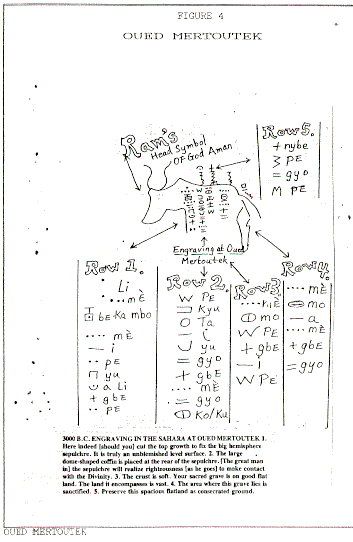
We were able to decipher the Oued Mertoutek inscription, and the Minoan Linear A, Harappan writing and the Olmec script because of the Vai script (Winters 1984a,1984b,1984c). Winters (1977,1979) discovered that the Vai syllabary of 200 characters matched all the signs in the syllabaries of Crete, Olmec America, Oracle Bone writing of China and the Harappan script (Winters 1979,1983b,1983c). And that due to the genetic linguistic unity of the people who made these signs, when you gave the signs in these diverse areas, the phonetic values of the Vai signs, but read them in the Dravidian or Manding language you could read the ancient literature of Crete and the Indus Valley (Winters 1985b). Thus the syllables which retain constant phonetic values can be used by different groups to write their own languages.
Many would-be decipherers have assumed that it is almost impossible to prove a genetic linguistic relationship using data of comparatively recent time-depth. But this view of archaeological decipherment is untenable. In fact, in the well known decipherments of Egyptian and Cuneiform, linguistic data of a comparatively recent time-depth was used to interpret the inscriptions. For example, Jean Champollion used Coptic to read the ancient Egyptian writing. And Sir Henry Rawlinson, the decipherer of the cuneiform script used Galla (a Cushitic language spoken in Africa) and Mahra ( a south Semitic language) to interpret the cuneiform writing. This meant that we could read the Proto-Saharan writing using recent Manding and Dravidian linguistic data.
This view is supported by the use of cuneiform writing by different groups in West Asia and Asia Minor. The cuneiform script was used to write many distinct languages including Akkadian, Elamite, Hurrian, Hittite and Sumerian. The key to deciphering the world of cuneiform writing was the fact that each sign had only one value.
As a result, to read a particular cuneiform script took only the discovery of the language written in the cuneiform script. Therefore the decipherment of the Persian cuneiform script provided the key to the cuneiform cognate scripts. The decipherment of the ancient Manding inscriptions using the Vai sounds, was the key to the decipherment of the Proto-Saharan scripts: Linear A, the Oracle Bone writing, the Olmec and the Harappan writing (Winters 1979, 1983b,1984).
The second oldest inscription in the Proto-Saharan script comes from Gebel Sheikh Suleiman in Nubia. The Gebel Sheikh Suleiman relief has been discussed by many scholars such as Williams (1987) and Trigger (1980).
The Gebel Sheikh Suleiman inscription is found near Buhen, Nubia. It is carved on a sandstone rock (see figure 5). This inscription was probably written by the A-Group people
who helped found ancient Egypt. The ancestors of the Egyptians or Kemites originally lived in Nubia. The Nubian origin of Egyptian civilization is supported by the discovery of artifacts by archaeologists from the University of Chicago's Oriental Institute, at Qustul (William 1987; Winters 1994).
On a stone incense burner found at Qustul we find a palace facade, a crowned King sitting on a throne in a boat, with a royal standard placed before the King and hovering above him, the falcon god Horus. The white crown on this Qustul king was later worn by the rulers of Upper Egypt.
Many Egyptologists were shocked to learn in 1979, that the A-Group of Nubia at Qustul used Egyptian type writing two hundred years before the Egyptians (Williams 1987). This fact had already been recognized much earlier by Anta Diop (1974) when he wrote that it was in Nubia "where we find the animals and plants represented in hieroglyphic writing".
The Qustul site was situated in a country called Ta-Seti. The name Ta-Seti means "Land of the Bow". Ta-Seti was the name given to Nubia by the Egyptians.
The Qustul incense burner indicates that the unification of Nubia preceded that of Egypt. The Ta-Seti had a rich culture at Qustul. Qustul Cemetery L had tombs that equaled or exceeded Kemite tombs of the First Dynasty of Egypt. The A-Group people were called Steu 'bowmen'. This shows that the Steu people used symbols that later became Egyptian writing.
The Steu had the same funeral customs, pottery, musical instruments and related artifacts of the Egyptians. Williams (1987, p.173,182) believes that the Qustul Pharaohs are the Egyptian Rulers referred to as the Red Crown rulers in ancient Egyptian documents.
Dr. Williams (1987) gave six reasons why he believes that the Steu of Qustul founded Egyptian or Kemite civilization:
1. Direct progression of royal complex designs from
Qustul to Hierakonpolis to Abydos.
2. Egyptian objects in Naqada III a-b tombs
3. No royal tombs in Lower and Upper Egypt.
4. Pharoanic monuments that refer to conflict in Upper Egypt.
5. Inscriptions of the ruler Pe-Hor, are older than Iry-Hor of Abydos.
6. The ten rulers of Qustul, one at Hierakonpolis and three at Abydos corresponds to the "historical" kings of late Naqada period.
The findings of Williams (1987), support the findings of Diop (1991,p.108) that "we also understand better now why the Egyptian term designating royalty etymologically means: (the man) who comes from the South= nsw< n y swt = who belongs to the South= who is a native of the South= the King of Lower Egypt, and has never meant just King, in other words king of Lower and Upper Egypt, King of all Egypt".
Williams (1987) and Trigger (1980) have failed to discuss the entire inscription on the Gebel Sheikh Suleiman relief. These scholars ignore the Proto-Saharan inscription, and describe only, the relief from left to right as follows: a serekh topped by a falcon looking over a victorious battlefield, sacred bark and a bound prisoner (see figure 5).
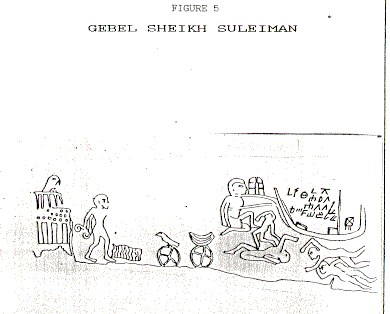
But in reality we find more than these figures on the Gebel Sheikh Suleiman inscription which appears to date back to the A-Group period of Nubia over 5000 years ago. This is obvious when we examine the photograph of the Gebel Sheikh Suleiman relief.
From left to right on this relief we see a falcon on a serekh sign surmounting a house/ palace. In front of this village/ palace scene we see a prisoner bound by Stj bow ( the sign for the Steu). Facing the prisoner bound by Stj bow ( the sign for the Steu). Facing the prisoner bound by the stj sign we see a bird over a circle with the letter X inside. Besides this scene we have another bird setting a top the letter X within the circle sign facing a victorious battle scene which includes a man bound to a sacred bark.
Over the sacred bark we find 21 Proto-Saharan signs. These signs agree with the Egyptian pottery symbols (see figure 3). The Gebel Sheikh Suleiman inscription is an obituary written about a king called Fe .

As noted above Homburger found that the Manding languages are closely related to the Coptic language. Using the Manding language we can read the Gebel Sheikh Suleiman inscription. Reading from right to left we read:
1. i gba lu
2. fe kye nde
2 1/2. ka i lu
3. fe fe tu
4. be yu su (su su) tu
5. su se lu gbe
6. po gbe tu
Below is the translation of the Gebel Sheikh Suleiman inscription:
"1. Thou family habitation, hold (it) upright. 2. Fe's estate (is on) the shore (of the watercourse). 2 1/2. Cut thou (sepulchre) habitation for the family (here). 3. Fe preferred to be obedient to the order. 4. Lay low the (celebrity) in the large hemisphere tomb (and) offer up libations that merit upright virtue.6. Pure righteousness (is) King (Fe)."
This King Fe, of Gebel Sheikh Suleiman, may relate to Pharoah Pe-Hor (Throne of Horus) since in African languages /f/ and /p/ are often interchangeable. It is interesting to note that there is an inscription on a storage jar from Cemetery L of Qustul, Nubia that reads Pe-Hor (Williams 1987, p. 164). This Pe-Hor may be the Fe, of the Gebel Sheikh Suleiman inscription.
EGYPTIAN WRITING
The Egyptians invented three scripts: hieroglyphic, hieratic and demotic. These scripts were used by the Egyptians for thousands of years.
The Egyptian hieroglyphic script was confined mainly to monuments. The hieratic writing was a simplified form of the hieroglyphics, used for day-to-day business for almost three millennia.
The Egyptian scripts were borrowed by other people in the Middle East, especially in the Sinai. The Protosinaitic script, was derived from Egyptian prototypes. It was this writing which was used by the Phoenicians and Greeks to form the alphabet we presently used.
Many Egyptian pottery signs agree with the Demotic script (see figure 6). The demotic script is the only Egyptian script that was used by just about every Egyptian. This writing was confined to ostraca and papyri.
The demotic script was used from the Seventh century B.C. to the Fifth century A.D. The demotic records were used by commercial, legal and administrative sectors of the Egyptian society.
Demotic signs were borrowed by other scripts. Six of the Coptic signs were derived from demotic, and many of the Meroitic signs are of demotic origin.
THE MEROITIC SCRIPT
The people of Meroe, the Kushites had their own alphabet of 23 signs.For many years we could read Meroitic phonetically but we could not read the words.
In 1974, Anta Diop at the UNESCO Symposium on the Decipherment of the Meroitic script proposed a methodological procedure based on the comparative method of linguistics and the Ancient Model to decipher the Meroitic script.The Ancient Model, simply means that the Greeks and Romans were right when they claimed that Civilization began in Africa/Egypt and that the ancient scholars knew much about African history scholars.
The ancient scholars believed that some of the people of Meroe came from India. One of the groups to formerly rule India were the Kushana people the language of the Kushana is called Tokharian today.
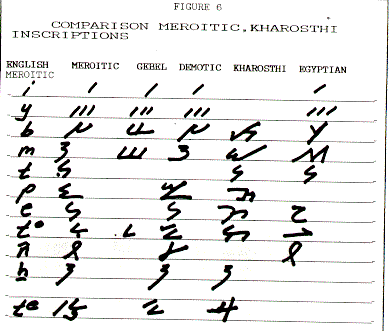
Using the comparative methods outlined by Diop, Clyde Ahmad Winters compared Tokharian (which has as its substratum languages Manding and Dravidian), to the Meroitic language as outlined by I. Hoffman and F. Hintze, in their grammars of Meroitic. This comparison showed that Kushana or Tokharian and Meroitic shared many affixes and words.
This comparison of Kushana and Meroitic suffixes led to the assumption that we could read the Meroitic script using the Kushana language. The fact that Kushana and the Dravidian and Manding languages are cognate meant the we might also be able to use terms from the these languages to help read Meroitic. This discovery proved valid and supported the methodological techniques outlined by Diop in 1974.
Meroitic is basically a suffixing language. The funerary tablets are written in the third person.
We have already deciphered many funerary tablets (Winters 1984b,1989b). The Meroitic inscriptions have the following order:
1) Invocation to Isis (Wosi) and Osiris (Sere) the gods of the dead;
2) Name of the deceased person; and
3) the obituary.
In the early Meroitic script the deceased requested passage to a revitalized Napata. In the later inscriptions the deceased asked to be sent to Khenel, Khenepi and or Bane, the
place(s) where the spirits dwell.
It appears that Woshi, was responsible for giving the dead person's Kha , the right to leave for paradise. Sere , was the god who guides the deceased person's Kha , to the afterworld(s).
There is also mention of Amon. Amon was recognized as the Supreme god of many people of the Meroitic Sudan (Winters 1995a, 1995b, n.d.). In figure 7, we see a stelae from Karanog (Winters, n.d.).
The funerary stelae from Karanog (fig.7) published by MacIver and Wooley , provides us with a good picture of the Meroitic religion and style of writing. On the front of the funerary stelae of Karanog we find the depiction of a woman with her hair tied in a top-knot, necklace around her neck and bangles on her arms. Above the head of this female figure we find wings. This stelae has fourteen (14) lines. The stelae is dedicated to a woman named Tqewine/ Tqowine.
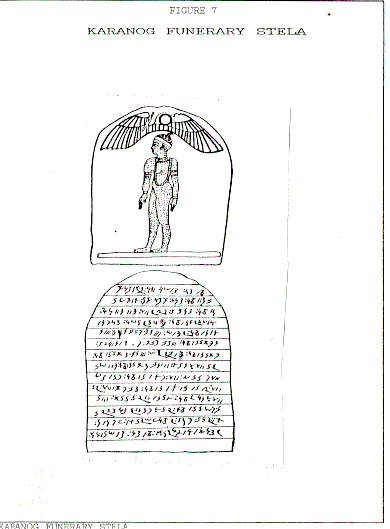
Below we will first give the transliteration of the Karanog stelae and then a translation of Meroitic into English. At the end of the translation we will provide a vocabulary of the text.
Line 1. Woshi ne Shore yi-ne t-po m-i d.
Line 2. Tqowine s li-ne t si d e-ne te o d he.
Line 3. Lo wi-ne sl h m-ne...s-ne qo. Qo li-ne
Line 4. Terike lo wi-ne...i l pe rine si b lo.
Line 5. Tel-o wi-ne pq r ne ye mtetl...e ne ye.
Line 6. Lq-ne lo win-ne yet sn net e i ol ye e-ne.
Line 7. M ne lo wi-ne... ot p kr-ne yet ne-ne e-o wi-ne.
Line 8. Pe sto lt-ne yet m n e e-o wi-ne qo re.
Line 9. St s t lete-ne s-ne tq lo wi-ne hle mr.
Line 10. S-ne q lo-t to lo wi-ne mte h ne s-n pe.
Line 11. Sto li h wi-ne t e lo lo-a en-ne ye.
Line 12. Tb h re lo wi-ne ato mh enep si se-a.
Line 13. Te-ne ato mh enep wi h r ke te-ne h ml-o l-ne.
Line 14. P-Sin ote m-i ke te-ne Wosi ne. Shore o-i ine.
TRANSLATION
"l. Isis the Good, and Osiris the Eternal (are) commanding the
measure (of) the bequeathal. (2) Tqowine, the patron to transmit
her satisfying bequeathal. She commands the beginning of the
bequeathal of the He. (3) The solitary honorable patron (is) to
behold the He-ne's (the abstract personality of man)...to prop up
the renewal. Act to (make) the conveyance. (4) (Its) the Fashion
to dispatch Awe...[h]i to remain to reproduce within satisfaction
from a distance. (5) The solitary object of respect to make
indeed a good voyage to Mtetl...[here] to be give(n) a good
existence.(6) She is to witness solitary reverence capable of
cleverly bowing in reverence (to the gods)--give leave to the /a
grand journey (Oh) Commander. (7) Measure the good (of the )
lonely object of Honor [lying in the grave]...esteem and dignity.
Adorn (her with) goodness, give opening to honor.(8) Your
nonexistent patron goes to measure goodness. Give (its) beginning
Now! The Object of Respect (Tqowine, to be) renewed indeed. (9)
Endorse the embarkation of the (good) Supporter. Set in Motion
the dispatch of this object of respect (Tqowine) to reverberate
luck. (10) The patron, she is present (in) the grave. Send the
Object of Respect to unlock H-ne [the place where the H, is kept]
--the Patron begs you. (11) Protect her conveyance of the H. This
honorable woman give (her) isolated departure. The Teacher (to
take) a journey. (12) Announce in a lofty voice indeed, the
dispatch of this Object of Respect (on the) path (of) the grand
bestowal (of) atonement (and ) favor. (13) Rebirth is the path to
grand bestowal of honor to the H , indeed give permission for the
rebirth of the H, and the soul to exit. (14) Much satisfaction
(and) wonder (to come) measure it. The permission (for its
bestowal ) is arranged by Isis,( and) Osiris (is) the Opener of
the Way."
References
Anselin,A. (1992). Samba, Gaudeloupe: Editions de L'Unirag.
Appiah,K.A.(1993). Europe upside down:Fallacies of the new Afrocentrism.Sapina Newsletter: A Bulletin of the Society for African Philosophy in North America,5(1), 1-8.
Bekerie,A. (1994). The four corners of a circle:Afrocentricity as a model of synthesis, Journal of Black Studies, 25(2), 131-149.
Cornelius, J. T. (1954)."The Dravidian Question", Tamil Culture 3,(2) , pages 92-102.
Cornelius, J. T. (1957-1957). "Are Dravidians Dynastic Egyptians",Transactions of the Archaeological Society of South India, 91-94.
David, H S. (1955). "Some contacts and affinities between the Egypto-Minoan and the Indo(-Dravido) Sumerian Culture",Tamil Culture 4, (2), 169-175.
Delafosse, M.(1899). "Vai leur langue et leur systeme d'ecriture", L'Anthropologie 10, .
Delafosse,M. (1929). La Langue Mandigue et ses dislectes, Paris: Geuthner, 1929.
Desplanges, L. (1906). "Notes sur les origines des populations
Nigerienne", L'Anthropologie 17, 525-527.
Desplanges, L.(1907). Le Plateau Central Nigerien , Paris.
Diop,C. A. (1974). The African Origin of Civilization, (ed & trans) by Mercer Cook, Westport:Lawrence Hill & Company.
Diop,C A.(1991).Civilization of Barbarism:An Authentic Anthropology,(trans ) by Yaa-Lengi Meema Ngemi and (ed) by H. J. Salemson and Marjoliiw de Jager, Westport:Lawrence Hill and Company.
Farid., El-Yahky.(1985) "The Sahara and Predynastic Egyptian Overview",The Journal for the Society for the Study Egyptian Antiquities 7, (1-2) , 58-65.
Farid ,El-Yahky.(1984). "The Origin and Development of sanctuaries in Predynastic Egypt", Journal of the Society for the Study of Egyptian Antiquities 14, no3 (1984), pages 70-73.
Graves, Robert.(1980). The Greek Myths, Middlesex:Penguin Books Ltd,2 vols.
Hau, K.(1967). "The ancient Writing of Southern Nigeria", Bulletin de l'IFAN 29, (1-2), 150-185.
Hau, K. (1973). "Pre-Islamic writing in West Africa", Bulletin de l'IFAN , series B, no1 .
Lahovary, N.(1957).Dravidian Origins and the West, Madras: Longman.
Kohl, R L.(1978). "The blance of trade in Southwest Asia in the mid-third millennium B.C.", Current Anthropology19, 463 -492.
Kramer,S.N.(1963). The Sumerians, Chicago:University of Chicago Press.
Meggars, B.T.(1975)."The Transpacific origin of Meso-American Civilization ", American Anthropologist 77, 10-11.
Muttarayan, K L.(1975) ."Sumerian, Tamil of the First Cankam", Journal of Tamil Studies, no7 ,41-61.
Nayar, T. B.(19770 , The Problem of Dravidian Origins, Linguistic,Anthropological Approach , Madras: Madras University Press.
Navarrete, C.(1976). "The Olmec rock carvings at Pijijipan, Chiapas, Mexico and other Olmec Pieces, from Chiapas and Guatemala",New World Archaeological Foundation, no35, Provo,Utah: Brigham Young University Press.
Obenga, Th.(1973). L'Afrique dans l"Antiquite, Paris:Presence Africaine.
Petrie, F.(1900). The Making of Egypt, London:The Sheldon Press.
Petrie,F.(1921). Corps of Prehistoric Pottery , London .
Soustelle,J. (1984). The Olmecs, New York:Doubleday & Com.,Inc.
Swadash, M , The Language of the Archaeological Huastecs, Carnegie Institutions Notes on Middle American Archaeology and Ethnology, no114, Washington, D C, 1953.
Trigger, B G.(1980) Nubia Under the Pharoahs, Boulder,Colorado: Westview Press .
Wiener, Leo , Africa and the Discovery of America, Philadelphia: Innes and Son,1920-22, 3 vols.
Williams, B The A-Group Royal Cemetery at Qustul: Cemetery L, Chicago:Oriental Institute University of Chicago, 1987.
Winters,Clyde Ahmad.(1977). "The influence of the Mande scripts on ancient American Writing systems", Bulletin l'de IFAN, T39,serie b, no2, 941-967.
Winters,C.A.(1979a)."Manding Scripts in the New World", Journal of African Civilization 1, no1 , 61-97.
Winters, C.A. (1980a)."The genetic unity of Dravidian and African languages and culture",Proceedings of the FirstInternational Symposium on Asian Studies (PIISAS) 1979, Hong Kong:Asian Research Service.
Winters, C.A.(1980b). "A Note on the Unity of Black Civilizations in Africa, IndoChina, and China",PISAS 1979, Hong Kong :Asian Research Service.
Winters,C.A.(1981a) "The Unity of African and Indian Agriculture", Journal of African Civilization 3, no1,103.
Winters,C.A.(1981b) "Are Dravidians of African Origin", P.Second ISAS,1980,( Hong Kong:Asian Research Service),789- 807.
Winters,C.A.(1982). "The Harappan script Deciphered:Proto- Dravidian Writing of the Indus Valley", P Third ISAS, 1981,(Hong Kong:Asian Research Service) 925-936.
Winters,C.A.(1983a)."The Ancient Manding Script",In Blacks in Science:Ancient and Modern, (ed) by Ivan van Sertima, (New Brunswick:Transaction Books ) pages 208-214.
Winters,C.A.(1983b). "Blacks in Ancient China,Part 1:The Founders of Xia and Shang", Journal of Black Studies (San Francisco) 1,no2 .
Winters,C.A.(1984a) "The Indus Valley Writing is Proto- Dravidian",Journal of Tamil Studies , no 25 (June 1984a), pp.50-64.
Winters,C.A.(1984b). "A Note on Tokharian and Meroitic", Meroitic Newsletter\Bulletin d"Information Meroitiques, No23 (Juin) , 18-21.
Winters, C.A.(1984c). "The Inspiration of the Harappan Talismanic Seals", Tamil Civilization 2, no1 (March ), pages 1-8.
Winters, C.A.(1984d). "The Harappan Writing of the Copper Tablets", Journal of Indian History LXll, nos.1-3 ,1-5.
Winters, C.A.(1985a). "The Proto-Culture of the Dravidians ,Manding and Sumerians", Tamil Civilization 3, no1 (March 1985a) ,pages 1-9.
Winters, C.A. (1985b). "The Indus Valley Writing and related Scripts of the 3rd Millennium BC", India Past and Present 2, no1 , pages 13-19.
Winters,C.A.(1985c). "The genetic Unity between the Dravidian ,Elamite, Manding and Sumerian Languages", P Sixth ISAS ,1984, (Hong Kong:Asian Research Service) 1413-1425.
Winters, C.A.(1986a) "The Migration Routes of the Proto-Mande", The Mankind Quarterly 27, no1 , pages 77-96.
Winters,C.A.(1988). "The Dravidian and Manding Substratum in Tokharian",Central Asiatic Journal 32, nos1-2,131-141.
Winters,C.A.(1989a)"Tamil,Sumerian and Manding and the Genetic Model",International Journal of Dravidian Linguistics 18,nol.
Winters,C.A.(1989b)."Cheikh Anta Diop et le dechiffrement de l'ecriture meroitique",Cabet:Revue Martinique de Sciences Humaines et de Litterature 8, 149-152.
Winters, C.A. (1991). The Proto-Sahara. In The Dravidian encyclopaedia (Vol.1, 553-556). Trivandrum, India: International School of Dravidian Linguistics.
Winters, C.A. (1994). Afrocentrism: A valid frame of reference, Journal of Black Studies,25, (2) 170-190.
Winters, C.A. (1995a). The Inscriptions of Tanyidamani, forthcoming Nubica, Iv or V.
Winters, C. A. (1995b).The Meroitic Chamber of Philae, forthcoming Nubica, Iv or V.
Winters, C.A. (n.d.). Meroitic inscriptions from Karanog. forthcoming Journal of the Society for the Study of Egyptian Antiquities.
Wulsin,F.R.(1941)The Prehistoric Archaeology of Northwest Africa, Papers of the Peabody Museum of American Archaeology and Ethnology, vol 19.
![]()
If you have comments or suggestions, email me at cwinters@kiwi.dep.anl.gov
This page created with Netscape Navigator Gold